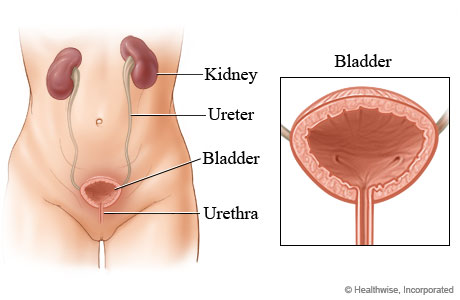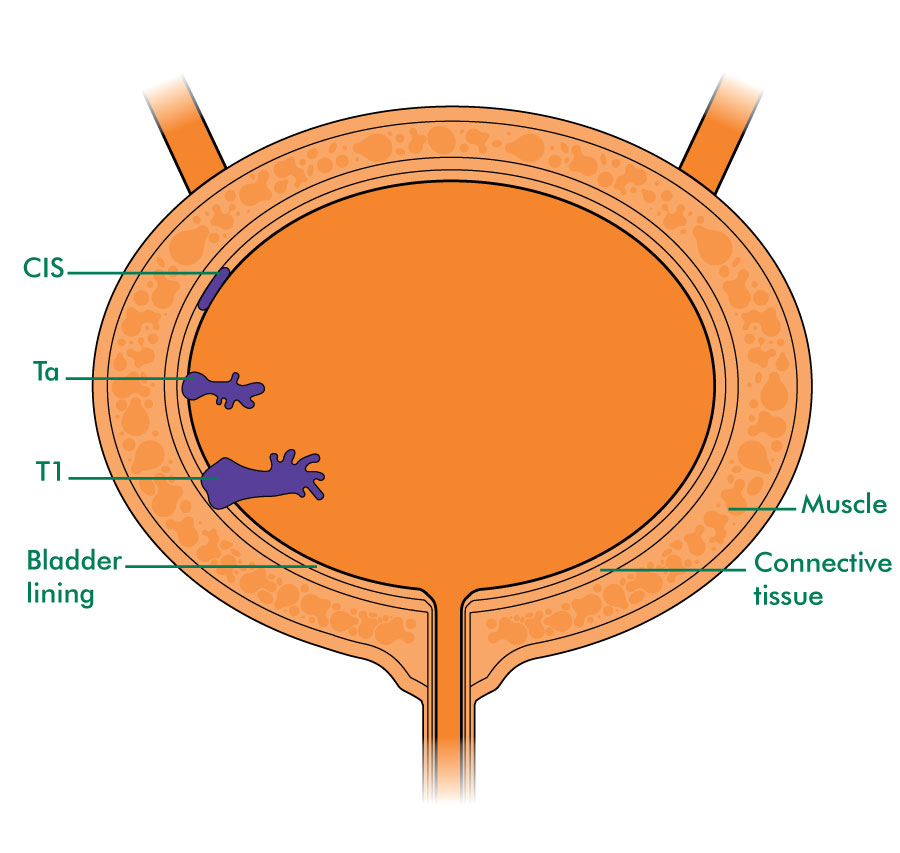Cancer of the bladder happens when abnormal cells appear in the lining of your bladder or in the bladder wall. Cancer cells can affect how the bladder works normally. The cells in the lining of the bladder (urothelium) are known as transitional cells. Because these cells line the bladder, they come into contact with waste products in the urine that may cause cancer, such as chemicals in cigarette smoke. About 90% of bladder cancers diagnosed in Ireland are the transitional cell type. Bladder cancer affects about 450 people in Ireland each year. It is more common in men than women.(source:www.cancer.ie)

Bladder cancer was the fourth most common cancer in Ireland for men and the twelfth most common for women, accounting for 1.9% of all malignant neoplasms, excluding non-melanoma skin cancer, in women and 4.4% in men (Table 11.1). The average number of new cases diagnosed each year was 193 in women and 479 in men. During 1995-2007, the number of new cases diagnosed per annum remained fairly constant.
The risk of developing bladder cancer up to the age of 74 was 1 in 212 for women and 1 in 72 for men and was slightly higher in RoI than in NI. At the end of 2008, 326 women and 787 men aged under 65, and 981 women and 2,527 men aged 65 and over, were alive up to 15 years after their bladder cancer diagnosis.(source:www.ncri.ie)
Types of bladder is determined by the type of cell in which the cancer have started and this helps the doctor to decide the right treament plan.
Transitional cell bladder cancer develops from the cells of the bladder lining. These are called transitional cells.
When the bladder is empty, these cells are all bunched together. When the bladder is full, they are stretched out into a single layer. These cells come into contact with waste products in the urine that may cause cancer, such as chemicals from cigarette smoke.
Transitional cell bladder cancers can behave in different ways. There are early (superficial) cancers that have not invaded the deeper layers of the bladder. And there are invasive cancers that have. They are treated differently, so it is important to know which kind you have.

(image source:http://www.macmillan.org.uk)
In early (superficial) bladder cancers, the cancer is only in the lining of the bladder. It has not grown into the deeper layers of the bladder wall.
Early bladder cancer usually appears as small growths, shaped like mushrooms. These grow out of the bladder lining. This is called papillary bladder cancer. Your surgeon can remove these growths and they may never come back.
But some types of non muscle invasive (superficial) bladder cancer are more likely to come back. These include carcinoma in situ (CIS) and high grade T1 tumours.
Unlike other superficial bladder cancers, areas of CIS are flat. They do not grow out of the bladder wall. In CIS the cancer cells look very abnormal and are likely to grow quickly. This is called high grade. It is more likely to come back than other types of superficial bladder cancer.
T1 tumours are superficial cancers that have grown from the bladder lining into a layer underneath, called the lamina propria. High grade T1 tumours are superficial cancers, but they can grow very quickly. About 30 to 40 out of every 100 (30 to 40%) T1 bladder cancers come back.
Doctors divide early bladder cancer into 3 risk groups. These risk groups describe how likely it is that your cancer will spread further or come back after treatment. Your risk group depends on several factors including the T stage, grade and type of bladder tumour.
The 3 risk groups are low risk, intermediate (medium) risk and high risk.
If you have high risk superficial bladder cancer, your doctor may suggest more treatment than for other superficial bladder cancers. The specialist keeps a close eye on you to make sure the cancer is picked up as early as possible if it does come back.
Transitional cell bladder cancer can become invasive. This means it has grown into a deeper (muscle) layer of the bladder, or beyond. Some people have invasive bladder cancer when they are first diagnosed.
Invasive bladder cancer needs more intensive treatment than early (superficial) bladder cancer. This is because there is a risk that it could spread to other parts of the body.
Squamous cells are flat cells that make up the moist, skin like tissues lining your body organs. This type of bladder cancer develops from these cells.
It is more common in developing countries where a worm infection called bilharzia or schistosomiasis is widespread.
This is a very rare type of bladder cancer. Between 1 and 2 out of every 100 people (1 to 2%) diagnosed with bladder cancer have it. It is usually invasive.
All the moist, skin like tissues lining your body organs have some gland cells that produce mucus. Adenocarcinoma develops from these cells in the lining of the bladder.
Very rarely, some people get a cancer of the bladder muscle or other structural tissues rather than the bladder lining. Cancers that start in the bladder muscle are called sarcomas.
This is a very rare type of bladder cancer. If you have it, you may have some of the treatments described in this section – for example, surgery and chemotherapy. But the chemotherapy drugs you have may be different. You must ask your own specialist how your treatment may differ.
Sometimes cancer that has started elsewhere in the body can spread to the bladder. This can happen with prostate, rectum, ovary, cervix and womb cancer for example.
Cancers that have spread from somewhere else in the body are called secondary cancers. The cancer cells are the same type as the first (primary) cancer. So is the treatment.
(Source:www.cancerresearchuk.org)